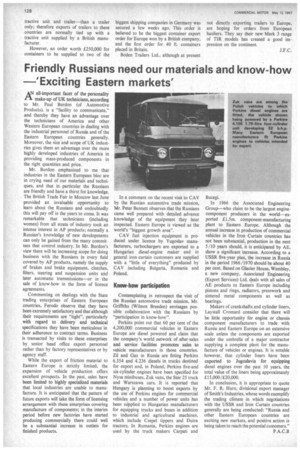Friendly Russians need our materials and know-how 'Exciting Eastern markets'
Page 130

If you've noticed an error in this article please click here to report it so we can fix it.
Nall-important facet of the personality
make-up of UK technicians, according to Mr. Paul Burdon (of Automotive Products), is a "facility to communicate," and thereby they have an advantage over the technicians of America and other Western European countries in dealing with the industrial personnel of Russia and of the Eastern European countries generally. Moreover, the size and scope of UK industries gives them an advantage over the more highly developed industries of America in providing mass-produced components in the right quantities and price.
Mr. Burdon emphasized to me that industries in the Eastern European bloc are in crying need of our materials and techniques, and that in particular the Russians are friendly and haVe a thirst for knowledge. The British Trade Fair in Moscow last June provided an invaluable opportunity to learn about the Russians and undoubtedly this will pay off in the years to come. It was remarkable that technicians (including women) from all strata of industry took an intense interest in AP products; normally a Russian's knowledge of new developments can only be gained from the many committees that control industry. In Mr. Burdon's view there will be increasing scope for doing business with the Russians in every field covered by AP products, namely the supply of brakes and brake equipment, clutches, filters, steering and suspension units and later automatic transmissions—or in the sale of know-how in the form of licence agreements.
Commenting on dealings with the State trading enterprises of Eastern European countries, Ferodo observe that they have been extremely satisfactory and that although their requirements are "tight", particularly with regard to delivery and technical specifications they have been meticulous in their adherence to contract terms. Business is transacted by visits to these enterprises by senior head office export personnel rather than by factory representatives or by agency staff.
While the export of friction material to Eastern Europe is strictly limited, the expansion of vehicle production offers excellent prospects. In the past, sales have been limited to highly specialized materials that local industries are unable to manufacture. It is anticipated that the pattern of future exports will take the form of licensing arrangement with these enterprises covering manufacture of components; in the interim period before new factories have started producing commercially there could well be a substantial increase in outlets for finished products. In a comment on the recent visit to CA V by the Russian automotive trade mission, Mr. Peter Bennett observes that the Russians came well prepared with detailed advance knowledge of the equipment they later inspected. Eastern Europe is viewed as the world's "biggest growth area".
CAV fuel injection equipment is produced under licence by Yugoslav manufacturers, turbochargers are exported to a Hungarian diesel-engine maker and in general iron-curtain customers are supplied with a "little of everything" produced by CAV including Bulgaria, Rumania and Poland.
Know-how participation
Contemplating in retrospect the visit of the Russian automotive trade mission, Mr. Griffiths (Wilmot Breeden) envisages possible collaboration with the Russians by "participation in know-how".
Perkins point out that 60 per cent of the 4,200,000 commercial vehicles in Eastern Europe are diesel powered and claim that the company's world network of after-sales and service facilities promotes sales to vehicle manufacturers in those countries. Zil and Gaz in Russia are fitting Perkins 6.354 and 4.236 diesels in trucks destined for export and, in Poland, Perkins five-and six-cylinder engines have been specified for Nysa minibuses, Zuk vans, the Star 25 truck and Warszawa cars. .It is reported that Hungary is planning to boost exports by the use of Perkins engines for commercial vehicles and a number of power units has been supplied to Hungarian manufacturers for equipping trucks and buses in addition to industrial and agricultural machines, which include Csepel tippers and Dutra tractors. In Rumania, Perkins engines are used by the truck makers Carpati and B ucegi.
In 1966 the Associated Engineering Group—who claim to be the largest enginecomponent producers in the world—exported £1.5m. component-manufacturing plant to Eastern Europe. Although the annual increase in production of commercial vehicles in the Iron Curtain countries has not been substantial, production in the next 5/10 years should, it is anticipated by AE, show a significant increase. According to a USSR five-year plan, the increase in Russia in the period 1966 /1970 should be about 40 per cent. Based on Glacier House, Wembley, a new company, Associated Engineering (Export Services) Ltd. deals with all sales of AE products to Eastern Europe including pistons and rings, radiators, presswork and sintered metal components as well as bearings.
Makers of crankshafts and cylinder liners, Laystall Cromard consider that there will be little opportunity for engine or chassis component manufacturers to trade with Russia and Eastern Europe on an extensive scale unless the components are exported under the umbrella of a major contractor supplying a complete plant for the manufacture of vehicles or engines. It is notable however, that cylinder liners have been exported to Jugoslavia for equipping diesel engines over the past 10 years, the total value of the liners being approximately £15,000 /£20,000.
In conclusion, it is appropriate to quote Mr. F. R. Hun, divisional export manager of Smith's Industries, whose words exemplify the trading climate in which negotiations with the USSR and Iron Curtain countries generally are being conducted: "Russia and other Eastern European countries are exciting new markets, and positive action is being taken to reach the potential customers."
P.A.C.B
















































































































































































































































